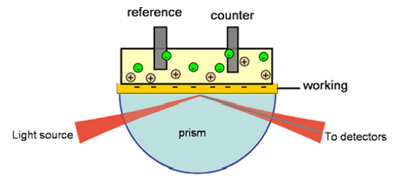BI’s unique Flow Injection SPR technique allows SPR analysis to be carried out in one continuous stream.
BI’S UNIQUE ELECTROCHEMICAL SPR TECHNIQUE ALLOWS SEAMLESS INTEGRATION OF SPR WITH ELECTROCHEMICAL MEASUREMENTS.

Check out our EC-SPR analysis modules for your electrochemistry research:
– EC-DualFlow™ analysis module
optional accessory for all models
– EC-SPR analysis module
included with BI-2000 series
Our electrochemical SPR technique is useful for a variety of applications:
Anodic stripping analysis
BI-SPR techniques combined with anodic stripping voltammetry are valuable in the detection of heavy metal ions at trace levels. This method is useful in screening biological/chemical analytes and monitoring trace levels of metal ions in surface water, soil, and other environment-related areas of research. Furthermore, it can be used in medical diagnostics for early detection of heavy metal poisoning.
Electropolymerization, electrodeposition, and corrosion
BI’s electrochemical SPR technique can be used to quantify both the amount of metal electrodeposited onto a surface and the reorganization of organic thin films upon redox reactions. By electroplating metal ions onto a gold sensor chip and detecting the SPR angular shift and electrochemical current signal, the type and amount of metal ions can be identified. Electropolymerization has also been the focus of increasing amounts of research due to its importance in such items as batteries and sensors, and its wide variety of applications in electrochemical technology. By using a three-electrode EC-SPR system, polymer thin films can be deposited on a gold film and monitored in real-time. Electrochemical research has continued to expand with the development of new polymer surfaces, which can easily be tested by using our interchangeable analysis modules.
Immunosensing (e.g., ligand-receptor, antibody-antigen, etc.)
Our BI-SPR techniques are very useful for label-free, real-time monitoring of the affinity and kinetics of antibody-antigen and ligand-receptor interactions. The concentration and distribution of target sites can yield important information about the functional consequences of binding, antibody characterization, immunogenicity, and more. Within research, antibodies have been used to elucidate details of biological processes and pinpoint therapeutic targets. Immunosensing is a powerful analytical technique that can be used for specific analysis and detection of a large variety of biomolecules, and our instruments provide the sensitivity necessary for superior results.
Conformational changes of immobilized redox molecules
Redox reactions are known to cause conformational changes in proteins and other molecules. Because these conformational changes are generally very small and fast, they can be very difficult to monitor. Here at BI, our instruments combine electrochemical and SPR techniques for a high-precision method to monitor the conformational changes of immobilized proteins taking place at or near an electrode surface. This, in turn, provides important information about the critical roles of these proteins and molecules in many different biological functions and processes. Our powerful and high-sensitivity detection technology delivers superior, high-quality data even for the fastest molecular processes.
Potential-controlled molecular adsorption and charge transfer processes
Electrochemical SPR studies can yield a wealth of information about the characteristics and kinetics of charge transfer chemical reactions and potential-controlled molecular adsorption and desorption processes. Certain proteins can be adsorbed onto a gold sensor surface via electrostatic interactions, the amount of which can be quantified and monitored by combining cyclic voltammetry and SPR techniques. BI’s SPR instruments have the sensitivity and precision to observe changes in optical properties due to protein conformational changes from the transfer of electrons.
- Application Note 101: Fast Kinetics of Conformational Changes in Proteins
- Application Note 102: Electrochemical SPR: Redox-Induced Protein Conformational Changes
- Application Note 103: Electrochemical SPR: Metal Deposition/Stripping and Reorganization of Electroactive Organic Thin Films
- Application Note 104: Flow-Injection SPR: Sensitive Determinations of Heavy Metal Ions
- Application Note: 111 - Measuring Surface Charge Density: A New Application with SPR
- Application Note: 113 - Flow-Through Electrochemical Surface Plasmon Resonance (SPR): Detection of Intermediate Reaction Products
